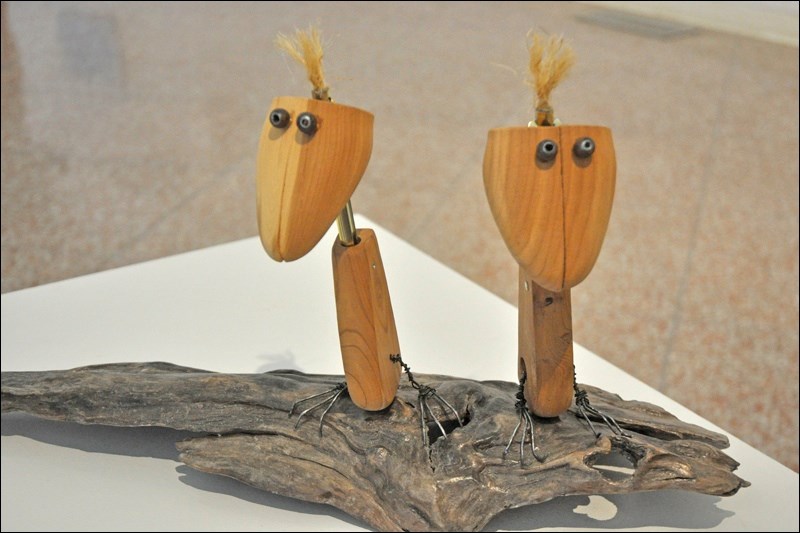Friday marked the official launch of a long-awaited exhibition based on one of the most impactful environmental disasters ever to hit the Battlefords.
The 2016 Husky oil spill into the North Saskatchewan River caused millions upon millions of dollars in damage and serious disruption to the water supply of North Battleford and other communities.
Now, the art community has responded with various works in the exhibition As Long as the River Flows: An Art Response to the North Saskatchewan River Oil Catastrophe.
The exhibition is co-curated by Leah Garven of The Chapel Gallery and Jesse Campbell of the Mann Art Gallery in Prince Albert. The Chapel Gallery held their exhibition reception event Friday evening with a number of artists taking part.
The effort has been years in the making. A few months after the oil spill took place in July 2016, a call went out from the Chapel Gallery for submissions of artwork including from mixed media, film, literary and emerging artists.
Despite a slow start to submissions, organizers persisted with the concept and ultimately received submissions from about 20 participants. The works featured in the exhibition include a wide range of paintings, poems and sculptures, including several submissions from new “emerging” artists.
Among those responding to the call for submissions was Saskatoon multimedia artist Monique Martin, mainly because of her own interest in environmental topics.
She had three pieces on display in North Battleford. One of her works was called “Now and Forever,” and featured a set of möbius bands with Saskatchewan fish printed on them using ink and used motor oil.
“When I first printed it they looked pretty crisp and everything was neat and clean, but then the oil kept moving and moving, and every time it’s exhibited it changes slightly, because the oil keeps moving on the paper.”
The use of oil as well as the möbius bands was meant to send a message about the “never-ending” environmental impact the oil has on animal and plant life.
“Once the oil enters the environment, it’s not leaving,” said Martin.
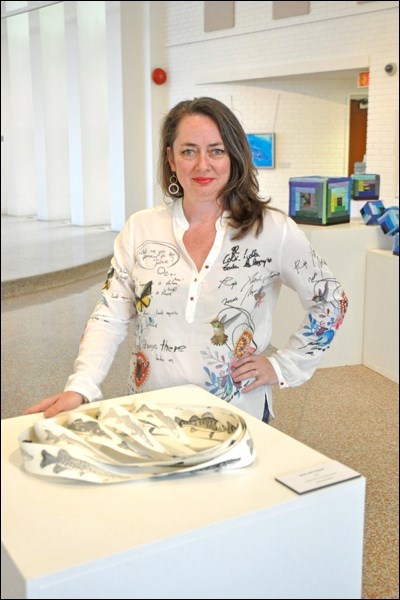
Another of Martin’s pieces was called “Collateral Damage” and featured an adding machine and rolls of tape with outlines of fish printed on them, illustrating the costs associated with the oil spill.
That particular piece, along with “Now and Forever” and other works, had already been exhibited in New York at the International Print Center last year.
“It’s making its rounds, making people think about the value of the environment,” said Martin.
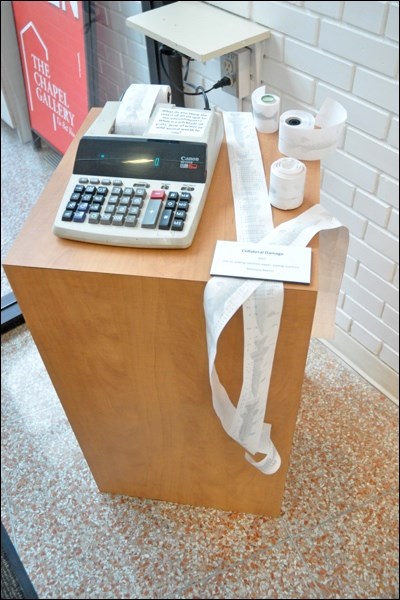
Another who answered the call for submissions was Laurie Blondeau. She is a project manager in her regular job in Saskatoon and new to the art scene, but she said she was encouraged to participate because of the exhibition’s call for emerging artists.
“They obviously wanted different perspectives and there is an opportunity,’ said Blondeau.
Blondeau said she has been “doing environmental art for a very long time and trying to express the impacts of different elements and things that we do to the earth that really impact us health-wise and otherwise.”
Two watercolour pieces were on display. One was called “Wonder of It?” and featured a couple of kids at a waterfall. If you look closely, one of the kids is outlined but not painted in.
A second watercolour was called “One by One,” in which two children are depicted climbing a rock. This time, neither one is painted in.
The intent, Blondeau said, was that “our children could go missing in the future if we don’t take care of what we have today.”
“I wanted to display it in a way that was not in your face, but obvious,” Blondeau said.
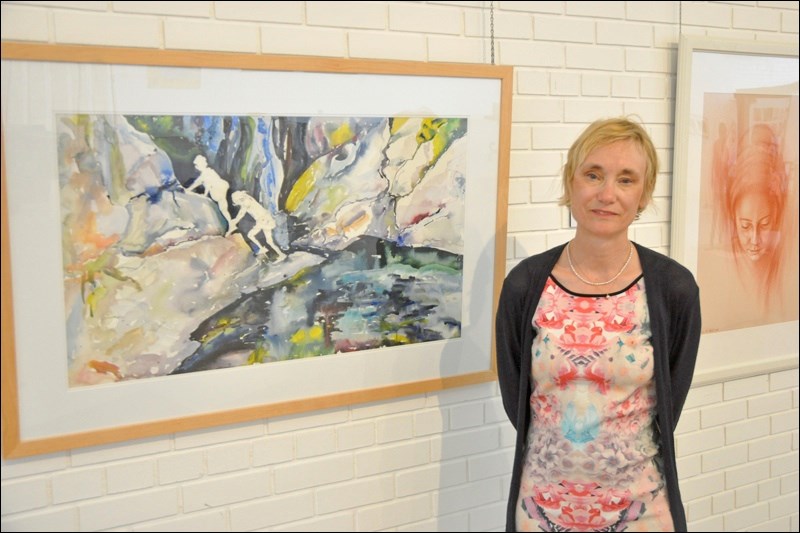
Some local artists had sculptures on display. One was Heather Hochbaum of Battleford, who also works at the Chapel Gallery.
Hochbaum’s display was called “To Lose or Not to Lose.” This work built upon her background as a traditional quilter, but it included a three-dimensional aspect as well.
It featured a number of cubes put together with free-motion quilting on a sewing machine, and included natural colours and depictions of water, wildlife and green areas.
Look closer, though, and you will also see shiny black strips on the cubes – representing the oil in the river.
The idea was to show the impact petroleum products would have on the river if they did not reduce their consumption.
“We have to smarten up and be more careful about how to use things,” Hochbaum said.
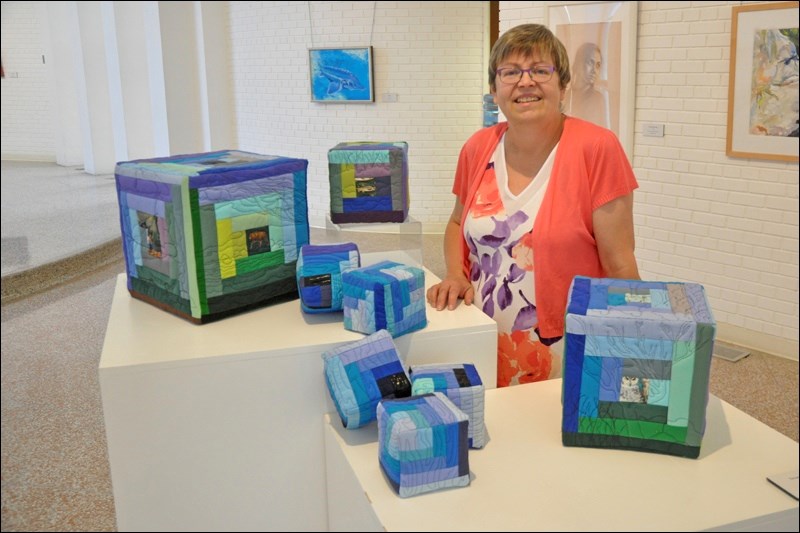
Hochbaum was motivated to take part because of the direct impact the spill had on the place she called home.
“It was such an impactful event for our communities, both in Battleford and North Battleford,” said Hochbaum.
She pointed to Battleford having to supply North Battleford with water during the crisis using a supply line across the river.
“You could see on the edge of the river the cleanup and those kind of things. It kind of drove it home that it was a major deal … It really hit home. Oil spills are nasty things.”
Two other local artists to take part were Cliff and Sherron Burns. Cliff provided a couple of poems about the spill: one called “Harbingers” and the other “Some Say It Will End in Fire.”
Sherron’s submission was a sculpture titled “Stranded.” The sculpture featured two amusing but forlorn-looking birds made from wooden shoehorns. The birds were depicted as standing on a piece of wood that might have floated down the river during the spill.
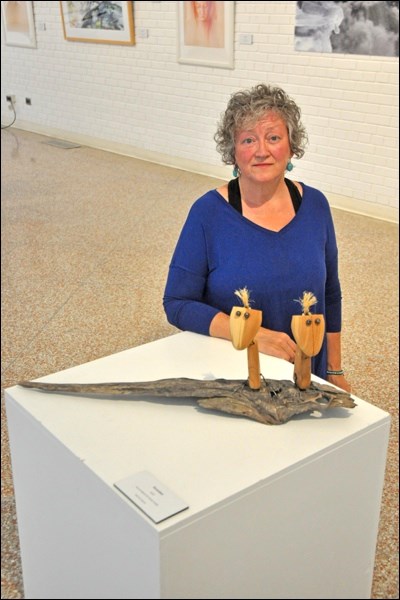
“They seem to be looking out at the world around them with a certain amount of despair,” she said.
Sherron said that when the call first went out for submissions, her first thought was about the water and the creatures that live on the water, and that inspired her to come up with the creation.
She welcomes the exhibition as a way for artists to be able to “make a statement about our water and our environment and protecting Mother Earth.”
“I think that’s a really important role that artists play in society is helping us make sense of things that seem incomprehensible at times.”
Her husband Cliff echoed that sentiment.
“To me, the artists are on the very front line of activism. They’re the ones that have their fingers on the pulse, they’re the ones that sense the Zeitgeist. Those are the people to go to if you want to know all the things to come.”
As Long as the River Flows will be on display at the Chapel Gallery until July 21. It is slated for the Mann Art Gallery in the summer of 2020.
